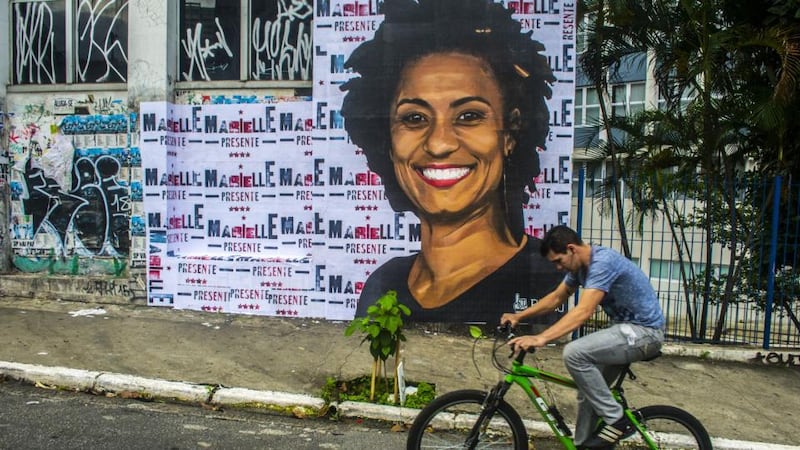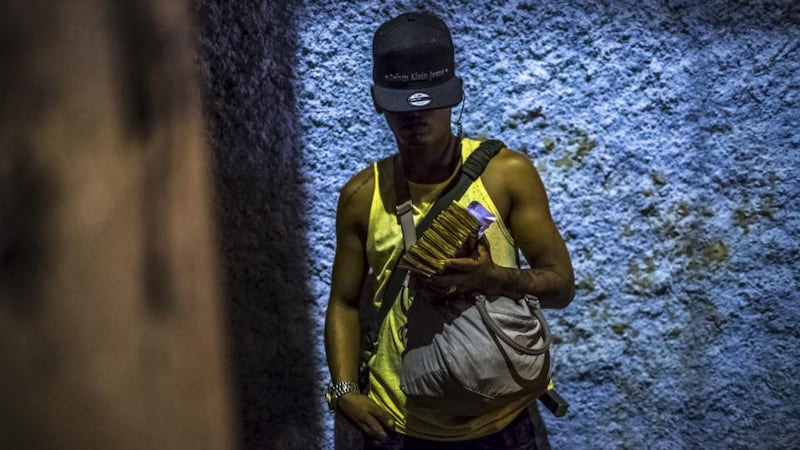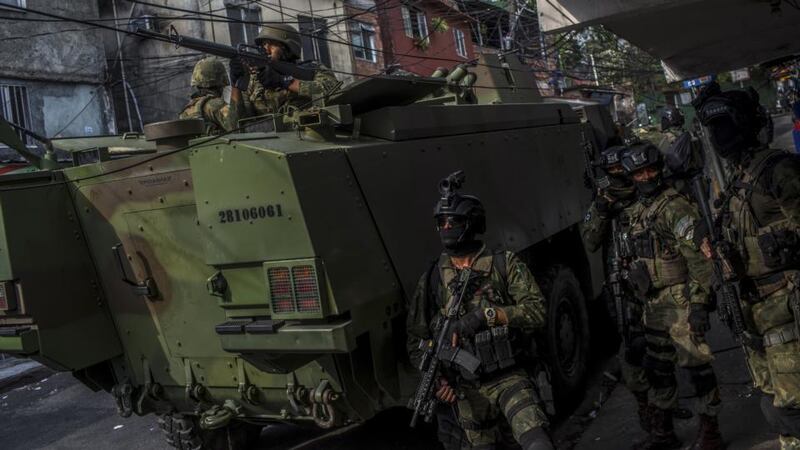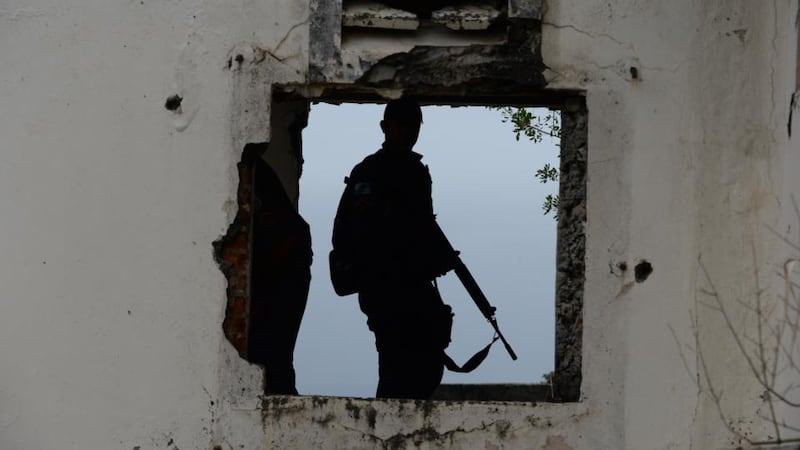The gang wore black military fatigues and ninja masks when they arrived in Seropédica, a nondescript town of 84,000 near Rio de Janeiro, and began systematically driving out the drug gangsters.Those who refused to leave were killed.
“There were three weeks of deaths,” says one resident – who like many locals is still unwilling to be named three years later. “Many people know. They just don’t open their mouths.”
Known as “militias”, paramilitary groups – which often include former and serving police officers and firefighters – have quietly taken control of swathes of the Brazilian city’s western suburbs since they emerged in the early 2000s.
Unlike Rio's drug gangs the militias do not man checkpoints nor patrol on motorbikes with machine guns slung over their shoulders – but they routinely murder those who cross them
As they did in Seropédica, they commonly arrive in a neighbourhood claiming they will drive out criminals and dealers – but soon start their own extortion and protection rackets. “It was like a tax, that’s what everyone said, to keep the security of the neighbourhood,” the resident says.
Since then various militia groups have exerted discreet yet effective control of Seropédica and other neighbourhoods across the hardscrabble flatlands around Rio, known as the Baixada Fluminense. Their money-making operations include controlling or extorting “taxes” on cooking-gas sales, pirate cable TV and internet networks, and minibus transport routes, among other businesses.
Unlike Rio’s drug gangs they do not man checkpoints nor patrol on motorbikes with machine guns slung over their shoulders – but they routinely murder those who cross them, disobey them or speak too freely about them. “Homicide is used as an instrument of force and to impose terror on the community,” says Daniel Braz, co-ordinator of Rio state prosecutors’ organised-crime group.
After years in the shadows Brazil’s militias are now back in the spotlight after the assassination in March of Marielle Franco, a black Rio city councillor, and her driver, Anderson Gomes.

Franco had been an outspoken critic of police killings in the city’s favelas, and her murder drew international condemnation and demands for an independent investigation. No arrests have been made over the double murder, but police believe militias were involved.
“They have the capacity for this, they have the weapons for this, they are more organised than the drug trade for this,” says Alexandre Herdy, head of Rio police’s organised-crime department. Franco’s killers were “professionals, for sure”.
Franco was on a council commission overseeing the “federal intervention” in which the army took over Rio’s crumbling security from its cash-strapped state government, which is so broke it can’t afford to repair police cars.
But before becoming a councillor she had also assisted a deputy in the state legislature, Marcelo Freixo, on a 2008 inquiry into the militias. That marked the first high-profile investigation of the groups, which before then had hidden under a veneer of respectability – and it led to hundreds of arrests. Freixo received death threats and lives under police protection to this day.
José Alves, a professor of social science and co-ordinator of a violence research group at the Federal Rural University of Rio de Janeiro in Seropédica, traced the militias’ roots to death squads formed in the 1970s by police officers in the Baixada. “It is a growing power structure, built on violence, death, summary execution,” he says.
When militias began appearing in west Rio neighbourhoods about 20 years ago, many residents initially welcomed the paramilitary gangs who styled themselves as “community self-defence” groups and promised to cut crime and drug dealing.
Many conservative Brazilians are happy to turn a blind eye to murderous solutions to the country’s violent-crime epidemic. And politicians initially refused to condemn the militias.

In 2006 the mayor of Rio, Cesar Maia, said they were “much less” of a problem than the drug trade. Eduardo Paes, who served as mayor during Rio’s Olympics, said they had “brought tranquillity” to west Rio’s Jacarepaguá neighbourhood.
“That’s how they expanded. They had this pseudo-moral agenda, to maintain order in those communities, committing homicides related to the issue of drug users and petty criminals,” says Fabio Corrêa, from the prosecutors’ organised-crime unit.
Nowadays about two million people live in militia-controlled areas, an investigation by the G1 news site found. The groups are always looking for new revenue streams, Braz says. In some places they parcel up and sell areas of land whose ownership is unclear. In Seropédica they also impose a “tax” on local sand quarries and construction companies.
But they also reduce street crime and obvious drug dealing – prompting some residents to describe them as a lesser evil. “Taking aside the bad things that the militias do – the way they kill people, their cruelty – in general I think they are a good thing,” says one Seropédica resident.
Connections to police officers and elected politicians help the militias sell this line of argument. When arrested, milicianos often try to convince police officers that they are on the same side, Herdy says, adding that police see drug gangsters and militia members differently because of the ways they react to arrest.
"The drug trade is dirtier," he says. "The trafficker will shoot at you; the miliciano still has the culture to not react . . . This has some weight."

Freixo’s 2008 inquiry into militias in Rio recommended charges against 225 people, including city councillors, police officers, prison officers and firefighters.
Among those later jailed were two police officers turned lawmakers: a state-legislature deputy named Natalino Guimarães and his brother Jerônimo Guimarães Filho, a city councillor. The two men were found guilty of running a militia group in west Rio called the Justice League, and they remain imprisoned.
Under different leaders a version of the Justice League is still Rio’s most powerful militia group, police and prosecutors say – and it is believed to have expanded its loose network into towns of the Baixada, including Seropédica.
The militias’ control of electoral propaganda in their territories has helped them build strong links with some local politicians. Speaking anonymously, a police source says that at least three of Rio’s serving councillors are believed to have close ties with the groups. “They are the only criminal group in Rio who transform territorial domination into political power,” says Freixo.

In May Rio's O Globo newspaper reported that a collaborating witness had testified to police that Franco's killing was organised by Orlando de Araújo, a former police officer and militia member, and Marcello Siciliano, a Rio councillor.
De Araújo – who is imprisoned for illegal possession of a firearm and faces charges of homicide and armed criminal organisation – denied the allegation in a letter from prison, according to local media. Siciliano denied the allegation at a press conference.
Brazil’s security minister, Raul Jungmann, confirmed that both men were being investigated.
Days later the TV Globo show Fantastico broadcast police wiretaps between Siciliano and an alleged militia member from Rio's west zone. Siciliano addressed the man as "brother" and signed off saying: "I love you, brother."
He told the programme he had no connections with militias.
Today Rio’s militias are changing, says Corrêa, the prosecutor. Some militias allow drug dealing in their territory, or have even made deals with the drug gangs. Meanwhile, some drug gangs have started to tax businesses and services.
It is increasingly hard to tell Rio’s criminal organisations apart. – Guardian









